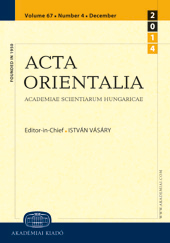Middle Mongol affricates and the reconstruction of (Pre-)Proto-Mongolic affricates
Middle Mongol affricates and the reconstruction of (Pre-)Proto-Mongolic affricates
Author(s): Pavel RykinSubject(s): Cultural history, Phonetics / Phonology, Morphology, Historical Linguistics, 13th to 14th Centuries, 15th Century, 16th Century
Published by: Akadémiai Kiadó
Keywords: Mongolic languages; Middle Mongol; Uighur-Mongol script; (Pre)-Proto-Mongolic reconstruction; historical phonology;
Summary/Abstract: The present paper deals with some particularities of affricates in Middle Mongol (13th – 16th centuries) as related to the problem of reconstructing the (Pre)-Proto-Mongolic consonant system. Three particularities of Middle Mongol affricates are especially highlighted: (1) č ~ ǰ alternation; (2) alliteration of the type č – ǰ or ǰ – č; (3) underdifferentiation of the medial č and ǰ in Uighur-Mongol script. Examples of the non-distinctive use of affricates in the Modern Mongolic languages as e.g. those spoken in Qinghai and Gansu provinces (Eastern Yugur and Shirongol) and the central Mongolic group (Khalkha, Buryat, Kalmyk) are given as well. The author comes to the conclusion that in Proto-Mongolic the distinction between *č and *ǰ may have been a phonemic one, while at the Pre-Proto-Mongolic stage *č and *ǰ were presumably free-variant allophones of the same consonant phoneme **C. Our reconstruction seems to be confirmed by the evidence from Khitan where alternation of the segments <c> and <dz> occurred, probably dating back to the Pre-Proto Mongolic stage.
Journal: Acta Orientalia Academiae Scientiarum Hungaricae
- Issue Year: 67/2014
- Issue No: 4
- Page Range: 425-452
- Page Count: 28
- Language: English
- Content File-PDF

